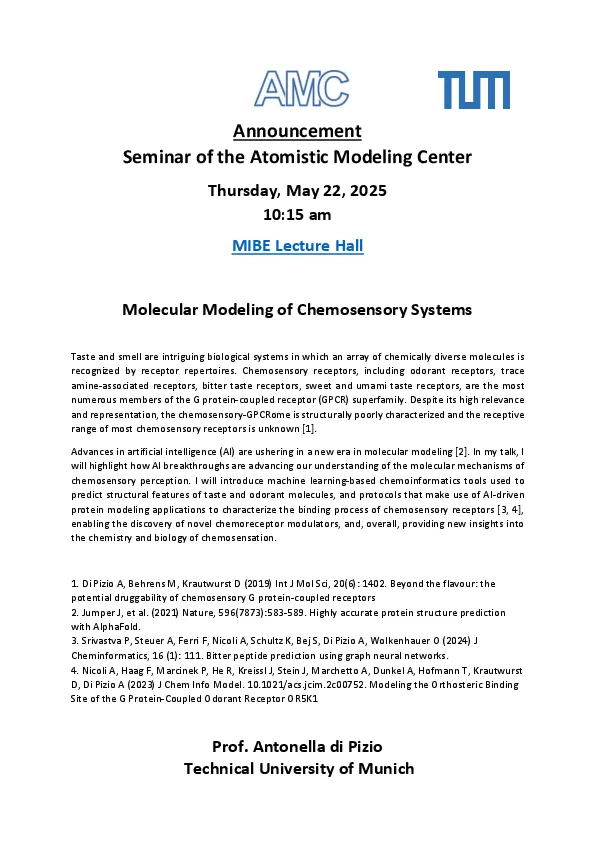AMC is offering a Seminar Series on Atomistic Modeling this summer semester!
Antonella Di Pizio leads the Molecular Modeling Group at the Leibniz Institute for Food Systems Biology and holds the Professorship for Chemoinformatics and Protein Modeling at TUM. She will give insights into the challenges of understanding chemosensory systems. Several chemosensory receptors, including odorant, bitter and sweet taste receptors, belong to the G protein-coupled receptor (GPCR) superfamily and are structurally poorly characterized. Consequently, uncovering the molecular mechanisms of chemosensory perception opens several application fields for AI-based molecular modeling methods. These include ML-based tools for predicting structural features and AI-driven protein modeling to characterize binding processes.
Date: May 22, 2025, 10:15 am
Location: MIBE Lecture Hall
Abstract:
Taste and smell are intriguing biological systems in which an array of chemically diverse molecules is recognized by receptor repertoires. Chemosensory receptors, including odorant receptors, trace amine-associated receptors, bitter taste receptors, sweet and umami taste receptors, are the most numerous members of the G protein-coupled receptor (GPCR) superfamily. Despite its high relevance and representation, the chemosensory-GPCRome is structurally poorly characterized and the receptive range of most chemosensory receptors is unknown [1].
Advances in artificial intelligence (AI) are ushering in a new era in molecular modeling [2]. In my talk, I will highlight how AI breakthroughs are advancing our understanding of the molecular mechanisms of chemosensory perception. I will introduce machine learning-based chemoinformatics tools used to predict structural features of taste and odorant molecules, and protocols that make use of AI-driven protein modeling applications to characterize the binding process of chemosensory receptors [3, 4], enabling the discovery of novel chemoreceptor modulators, and, overall, providing new insights into the chemistry and biology of chemosensation.
Short bio:
Prof. Di Pizio completed a PhD in Drug Sciences at the University of Chieti (Italy) in 2012, followed by a research stay at the University of Marburg (Germany) and a postdoc at The Hebrew University of Jerusalem (Israel). Since 2018, she has led the Molecular Modeling group at the Leibniz Institute for Food Systems Biology at TUM. The research of Prof. Di Pizio spans a wide range of computational chemistry areas, extending from the analyses of small molecules to the investigation of biomolecular interactions. Through innovative computational tools, her research group develops predictive models to screen and rationally design new bioactive compounds that can be used for food reformulation or therapeutic indications. A primary research interest of Prof. Di Pizio lies in taste and olfactory G protein-coupled receptors, which play a crucial role in mediating chemosensory perception and are also involved in other physiological functions when ectopically expressed.
[1.] Di Pizio A, Behrens M, Krautwurst D (2019) Int J Mol Sci, 20(6): 1402. Beyond the flavour: the potential druggability of chemosensory G protein-coupled receptors
[2.] Jumper J, et al. (2021) Nature, 596(7873):583-589. Highly accurate protein structure prediction with AlphaFold.
[3.] Srivastva P, Steuer A, Ferri F, Nicoli A, Schultz K, Bej S, Di Pizio A, Wolkenhauer O (2024) J Cheminformatics, 16 (1): 111. Bitter peptide prediction using graph neural networks.
[4.] Nicoli A, Haag F, Marcinek P, He R, Kreissl J, Stein J, Marchetto A, Dunkel A, Hofmann T, Krautwurst D, Di Pizio A (2023) J Chem Info Model. 10.1021/acs.jcim.2c00752. Modeling the Orthosteric Binding Site of the G Protein-Coupled Odorant Receptor OR5K1
